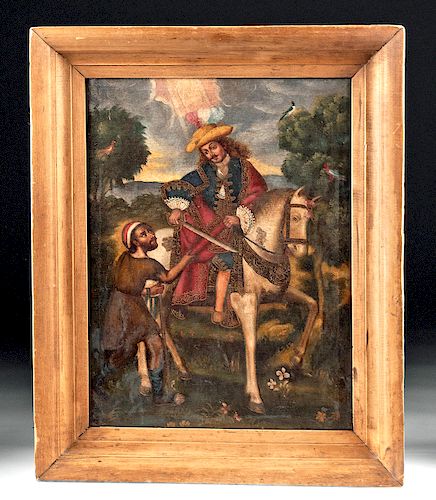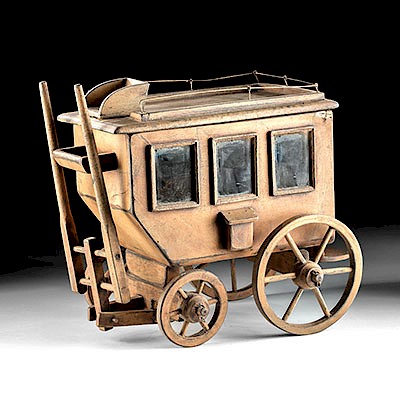18th C. Spanish Colonial Painting San Martin de Tours
Lot 172a
About Seller
Artemis Gallery
686 S Taylor Ave, Ste 106
Louisville, CO 80027
United States
Selling antiquities, ancient and ethnographic art online since 1993, Artemis Gallery specializes in Classical Antiquities (Egyptian, Greek, Roman, Near Eastern), Asian, Pre-Columbian, African / Tribal / Oceanographic art. Our extensive inventory includes pottery, stone, metal, wood, glass and textil...Read more
Estimate:
$1,600 - $2,200
Absentee vs Live bid
Two ways to bid:
- Leave a max absentee bid and the platform will bid on your behalf up to your maximum bid during the live auction.
- Bid live during the auction and your bids will be submitted real-time to the auctioneer.
Bid Increments
| Price | Bid Increment |
|---|---|
| $0 | $25 |
| $300 | $50 |
| $1,000 | $100 |
| $2,000 | $250 |
| $5,000 | $500 |
| $10,000 | $1,000 |
| $20,000 | $2,500 |
| $50,000 | $5,000 |
| $100,000 | $10,000 |
| $200,000 | $20,000 |
About Auction
By Artemis Gallery
Nov 14, 2019
Set Reminder
2019-11-14 10:00:00
2019-11-14 10:00:00
America/New_York
Bidsquare
Bidsquare : Ethnographic | Tribal | American Frontier
https://www.bidsquare.com/auctions/artemis-gallery/ethnographic-tribal-american-frontier-4634
Featuring Pre-Columbian, Tribal / Oceanic, Spanish Colonial, historical examples from the Spanish, Mexican, and American frontiers, fossils, and more. All items offered for sale have been legally acquired, are legal to sell and are guaranteed to be as described or your money back. Artemis Gallery info@artemisgallery.com
Featuring Pre-Columbian, Tribal / Oceanic, Spanish Colonial, historical examples from the Spanish, Mexican, and American frontiers, fossils, and more. All items offered for sale have been legally acquired, are legal to sell and are guaranteed to be as described or your money back. Artemis Gallery info@artemisgallery.com
- Lot Description
Spanish Colonial, possibly Peruvian, ca. 18th century CE. A finely painted oil on canvas depicting the theme of San Martin de Tours (Saint Martin and the Beggar), presenting the Christian Saint Martin of Tours as a young caballero on his white horse, cutting off half of his cloak with a sword to give to the beggar below. The saint wears luxurious red, white, and blue vestments with gold embroidered and white lace trims, along with red, white, and blue feathers in his wide-brimmed hat. In contrast, the beggar is scantily clad and has a hole in his shoe. The hallowed event is taking place in a verdant setting with colorful birds perched in the leafy boughs of trees to either side of the pair, flowers growing amidst the grasses below, and holy light streaming down upon Saint Martin's fair-skinned, bearded face with heavenly blue skies beyond. Size: 21" L x 15.75" W (53.3 cm x 40 cm); 26.25" L x 21.25" W (66.7 cm x 54 cm) framed
An old label on the verso has a handwritten inscription that states in Spanish: "San Martin - Colecion Privata - Lima - de pintor anonimo. Siglo XVII-XVIII mas o menos. El paisaje no tipico del Peru, pese a la adiao (?) de aves y flores locales de no la de parte del artista, sentido de adaptacion." This generally translates, "Saint Martin - Private Collection - Lima - by anonymous painter. Ca. 17th to 18th century. The landscape not typical of Peru … not usual local birds and flowers - as the artist took artistic license with this adaptation."
The story of Saint Martin of Tours: When stationed in Amiens one harsh winter day, a poor man, trembling from the cold, was begging at the gates to the city. Martin took notice, and recognized that nobody was paying attention to him. So, he cut his cloak in two and covered the beggar with half of it. That night when Martin was asleep he had a vision of Jesus wearing the half-cloak saying, "Martin yet a catechumen has covered me with the garment," and Martin was baptized. Today, Saint Martin of Tours is invoked when someone is cold or lacking in clothing. He also the patron saint of beggars, tailors, shirt-makers, and soldiers.
Provenance: private San Francisco, California, USA collection
All items legal to buy/sell under U.S. Statute covering cultural patrimony Code 2600, CHAPTER 14, and are guaranteed to be as described or your money back.
A Certificate of Authenticity will accompany all winning bids.
We ship worldwide and handle all shipping in-house for your convenience.
#150658Old label on the verso identifying it as from a Peruvian collection and dating to 17th to 18th century. (See extended description for this inscription and a translation.) Below this is a white rectangle (perhaps where another label was once affixed) with "16" (perhaps a collection or exhibition number) handwritten at the upper and lower right corners. Verso of canvas has darkened with age. No visible repairs to the canvas. Painting shows slight impressions from the stretcher bars on the verso, expected scuffs here and there, some darkening and expected stains. But overall it is in very good condition and shows nice areas of craquelure. Frame is old but dates later than the painting. It is in very good condition save a few minor nicks and scuffs.Condition
- Shipping Info
-
All shipping is handled in-house for your convenience. Your invoice from Artemis Gallery will include shipping calculation instructions. If in doubt, please inquire BEFORE bidding for estimated shipping costs for individual items.
-
- Buyer's Premium



 EUR
EUR CAD
CAD AUD
AUD GBP
GBP MXN
MXN HKD
HKD CNY
CNY MYR
MYR SEK
SEK SGD
SGD CHF
CHF THB
THB
















